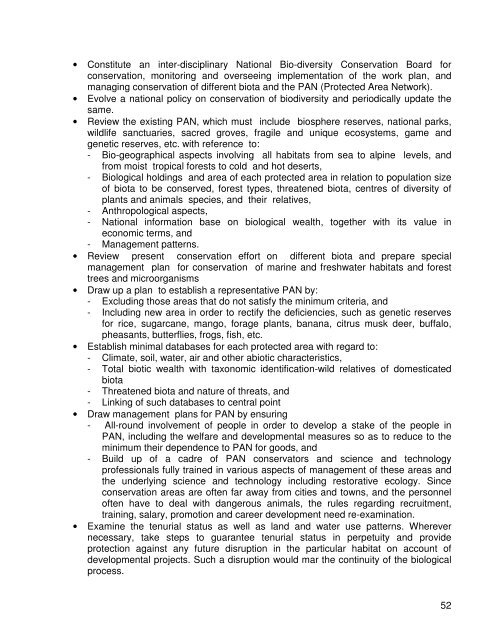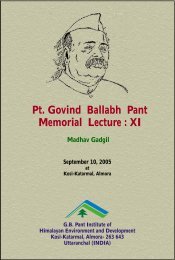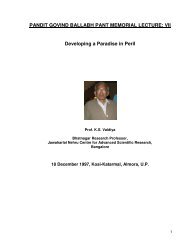Pandit Govind Ballabh Pant Memorial Lecture: II
Pandit Govind Ballabh Pant Memorial Lecture: II
Pandit Govind Ballabh Pant Memorial Lecture: II
You also want an ePaper? Increase the reach of your titles
YUMPU automatically turns print PDFs into web optimized ePapers that Google loves.
• Constitute an inter-disciplinary National Bio-diversity Conservation Board for<br />
conservation, monitoring and overseeing implementation of the work plan, and<br />
managing conservation of different biota and the PAN (Protected Area Network).<br />
• Evolve a national policy on conservation of biodiversity and periodically update the<br />
same.<br />
• Review the existing PAN, which must include biosphere reserves, national parks,<br />
wildlife sanctuaries, sacred groves, fragile and unique ecosystems, game and<br />
genetic reserves, etc. with reference to:<br />
- Bio-geographical aspects involving all habitats from sea to alpine levels, and<br />
from moist tropical forests to cold and hot deserts,<br />
- Biological holdings and area of each protected area in relation to population size<br />
of biota to be conserved, forest types, threatened biota, centres of diversity of<br />
plants and animals species, and their relatives,<br />
- Anthropological aspects,<br />
- National information base on biological wealth, together with its value in<br />
economic terms, and<br />
- Management patterns.<br />
• Review present conservation effort on different biota and prepare special<br />
management plan for conservation of marine and freshwater habitats and forest<br />
trees and microorganisms<br />
• Draw up a plan to establish a representative PAN by:<br />
- Excluding those areas that do not satisfy the minimum criteria, and<br />
- Including new area in order to rectify the deficiencies, such as genetic reserves<br />
for rice, sugarcane, mango, forage plants, banana, citrus musk deer, buffalo,<br />
pheasants, butterflies, frogs, fish, etc.<br />
• Establish minimal databases for each protected area with regard to:<br />
- Climate, soil, water, air and other abiotic characteristics,<br />
- Total biotic wealth with taxonomic identification-wild relatives of domesticated<br />
biota<br />
- Threatened biota and nature of threats, and<br />
- Linking of such databases to central point<br />
• Draw management plans for PAN by ensuring<br />
- All-round involvement of people in order to develop a stake of the people in<br />
PAN, including the welfare and developmental measures so as to reduce to the<br />
minimum their dependence to PAN for goods, and<br />
- Build up of a cadre of PAN conservators and science and technology<br />
professionals fully trained in various aspects of management of these areas and<br />
the underlying science and technology including restorative ecology. Since<br />
conservation areas are often far away from cities and towns, and the personnel<br />
often have to deal with dangerous animals, the rules regarding recruitment,<br />
training, salary, promotion and career development need re-examination.<br />
• Examine the tenurial status as well as land and water use patterns. Wherever<br />
necessary, take steps to guarantee tenurial status in perpetuity and provide<br />
protection against any future disruption in the particular habitat on account of<br />
developmental projects. Such a disruption would mar the continuity of the biological<br />
process.<br />
52











